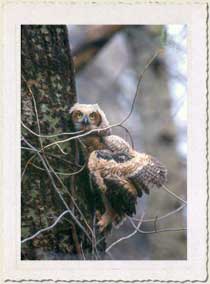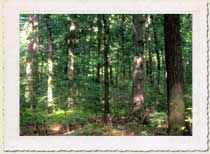
Arden Heights Woods Preserve
Borough: Staten Island
Acres: 185
Habitat Type: Forest, Freshwater Wetland
Map: PDF
Most of Arden Heights Woods is a forested hardwood swamp, and is the largest wetlands that the Department of Environmental Conservation has classified anywhere in the New York metropolitan area. It contains several kettle ponds which are connected by an intricate network of streams and creeks. As such, it provides natural flood control for the area, making a more complicated (and expensive) man-made sewage system unnecessary.
The forests throughout the property are called successional forests. This is because they undergo a multi-stage lifecycle, beginning as open fields and maturing into hardwood forests. In the mature, or climax, portions of these forests live a multitude of trees, including hemlocks (Tsuga canadensis), black cherry (Prunus serotina), and persimmons (Diospyros). Perhaps most interesting of all the species present is the eastern white pine (Pinus strobus). During the early colonial period, wood from these trees was used for masts by the British Navy. The wood is five times lighter than white oak (Quercus alba), and therefore more suitable for seagoing vessels. This natural resource helped establish Staten Island as a maritime community early in its history.
In the swamps, there are two particularly notable species of plant life. The first, blue flags iris (Iris veriscolor) blooms from May through July, with its namesake violet blue flowers. These plants can be recognized by their sword-like leaves even when not in bloom. The second, the common reeds, or phragmites, are members of the grass family. They thrive in both brackish and fresh water marshes, and can grow to be 12 feet tall. Phragmites often invade wetlands at the expense of other native marsh plants.
Many owls frequent this site, including the screech owl (Otus asio), saw whet owl (Aegolius acadicus), great horned owl (Bubo virginianus), and the barn owl (Tyto alba). Occasionally, a barred owl (Strix varia) from the south will venture this far north. This bird is known as the “Southern Gentleman” because it makes the distinct sound suggestive of “who cooks for you, who cooks for you-all.” Bats come here for shelter and food, and the swamp’s ample insect population helps satisfy their appetite; in one year, the average bat consumes fifty times its body weight in insects.
Photographs
Directions
Public Transit: From the Staten Island Ferry, take the S91 bus and transfer to the S56 at Marsh Ave. Take the S56 to Arden Ave. and Nedra Lane (near the King Kullen shopping center). There are visible trailheads on the side of Arden Ave. between Wooddrow Road and Arthur Kill Road.
By Car: From the West Shore Expressway (440), take Exit 5 (southbound) or Exit 4 (northbound) for Arden Ave. (Southbound) Drive east on Arthur Kill Rd. and make a right on Arden Ave. and the preserve will be less than ¼ mile on the left after Arthur Kill Road. (Northbound) make a left at stop sign and the preserve will be less than ¼ mile past the first stop light on the left side of the street.

